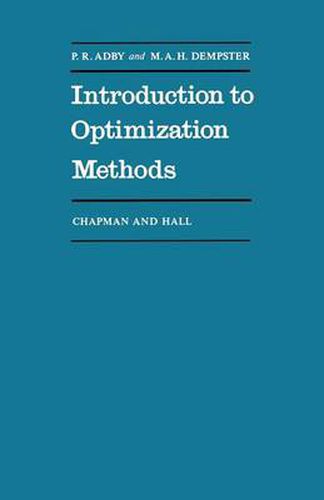Readings Newsletter
Become a Readings Member to make your shopping experience even easier.
Sign in or sign up for free!
You’re not far away from qualifying for FREE standard shipping within Australia
You’ve qualified for FREE standard shipping within Australia
The cart is loading…






This title is printed to order. This book may have been self-published. If so, we cannot guarantee the quality of the content. In the main most books will have gone through the editing process however some may not. We therefore suggest that you be aware of this before ordering this book. If in doubt check either the author or publisher’s details as we are unable to accept any returns unless they are faulty. Please contact us if you have any questions.
During the last decade the techniques of non-linear optim ization have emerged as an important subject for study and research. The increasingly widespread application of optim ization has been stimulated by the availability of digital computers, and the necessity of using them in the investigation of large systems. This book is an introduction to non-linear methods of optimization and is suitable for undergraduate and post graduate courses in mathematics, the physical and social sciences, and engineering. The first half of the book covers the basic optimization techniques including linear search methods, steepest descent, least squares, and the Newton-Raphson method. These are described in detail, with worked numerical examples, since they form the basis from which advanced methods are derived. Since 1965 advanced methods of unconstrained and constrained optimization have been developed to utilise the computational power of the digital computer. The second half of the book describes fully important algorithms in current use such as variable metric methods for unconstrained problems and penalty function methods for constrained problems. Recent work, much of which has not yet been widely applied, is reviewed and compared with currently popular techniques under a few generic main headings. vi PREFACE Chapter I describes the optimization problem in mathemat ical form and defines the terminology used in the remainder of the book. Chapter 2 is concerned with single variable optimization. The main algorithms of both search and approximation methods are developed in detail since they are an essential part of many multi-variable methods.
$9.00 standard shipping within Australia
FREE standard shipping within Australia for orders over $100.00
Express & International shipping calculated at checkout
This title is printed to order. This book may have been self-published. If so, we cannot guarantee the quality of the content. In the main most books will have gone through the editing process however some may not. We therefore suggest that you be aware of this before ordering this book. If in doubt check either the author or publisher’s details as we are unable to accept any returns unless they are faulty. Please contact us if you have any questions.
During the last decade the techniques of non-linear optim ization have emerged as an important subject for study and research. The increasingly widespread application of optim ization has been stimulated by the availability of digital computers, and the necessity of using them in the investigation of large systems. This book is an introduction to non-linear methods of optimization and is suitable for undergraduate and post graduate courses in mathematics, the physical and social sciences, and engineering. The first half of the book covers the basic optimization techniques including linear search methods, steepest descent, least squares, and the Newton-Raphson method. These are described in detail, with worked numerical examples, since they form the basis from which advanced methods are derived. Since 1965 advanced methods of unconstrained and constrained optimization have been developed to utilise the computational power of the digital computer. The second half of the book describes fully important algorithms in current use such as variable metric methods for unconstrained problems and penalty function methods for constrained problems. Recent work, much of which has not yet been widely applied, is reviewed and compared with currently popular techniques under a few generic main headings. vi PREFACE Chapter I describes the optimization problem in mathemat ical form and defines the terminology used in the remainder of the book. Chapter 2 is concerned with single variable optimization. The main algorithms of both search and approximation methods are developed in detail since they are an essential part of many multi-variable methods.